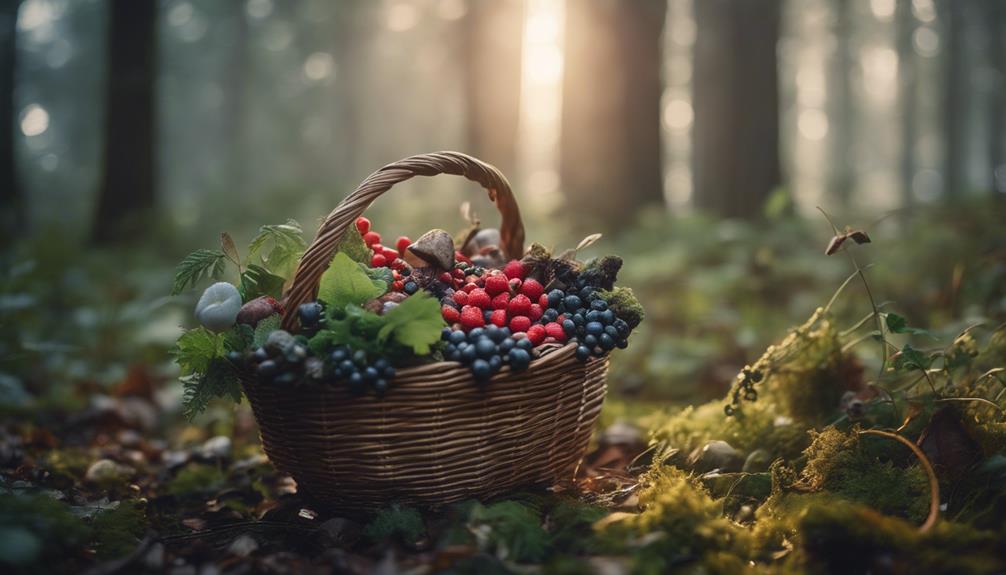You can discover wild garlic in the UK, where it thrives in woodland edge habitats and shaded damp areas, particularly in old woodlands and near water sources, making it abundant in the country's temperate climate. To identify wild garlic, look for its pungent aroma, bulbous perennial plant with long, pointed leaves, and small white flowers. When foraging, positively identify the plant, obtain permission if needed, and harvest leaves and flowers responsibly. Now that you know wild garlic is waiting to be found, learn how to make the most of this culinary treasure and access its nutritional benefits.
Key Takeaways
- Wild garlic thrives in the UK's temperate climate, commonly found in woodland edge habitats, near water sources, and shaded damp areas.
- Positively identify the plant before harvesting to ensure you're picking wild garlic and not a lookalike.
- Obtain permission before foraging in protected areas, and leave enough for wildlife and future foragers to maintain sustainability.
- Harvest wild garlic leaves and flowers responsibly to avoid uprooting plants and causing habitat damage.
- Wild garlic is abundant in old woodlands and near water sources in the UK, making it a readily available foraging option.
What Is Wild Garlic?
You'll likely recognize wild garlic, also known as ramsons, by its pungent aroma, similar to the smell of garlic, wafting from the damp, shady woodlands where it grows abundantly. This bulbous perennial plant is characterized by its long, pointed leaves and small white flowers.
As you explore the woodland, you'll notice that wild garlic emits a strong garlic scent, making it easily recognizable. The good news is that wild garlic is edible, and both its leaves and flowers can be used in various culinary dishes. When foraging for wild garlic, you'll find that it adds a mild garlic flavor to your recipes.
This versatile ingredient is popular among foragers due to its abundance in woodlands, making it an ideal addition to many meals. As you venture into the world of foraging, keep an eye out for wild garlic's distinctive aroma and appearance, and get ready to elevate your cooking with this delicious and accessible ingredient.
Where to Find Wild Garlic

As you start your wild garlic foraging adventure, you'll want to know where to look. You'll typically find it thriving in woodland edge habitats, shaded damp areas, and along stream sides and banks.
Woodland Edge Habitats
When foraging for wild garlic in the UK, head to woodland edge habitats, where the shady, damp conditions create the perfect environment for this pungent plant to thrive. As you wander through the woodland floors, keep an eye out for the distinctive garlic smell that wafts through the air, signaling the presence of wild garlic. During the wild garlic season, these areas are particularly conducive to finding this fragrant herb.
| Location | Tips | Best Time |
|---|---|---|
| Woodland edges | Look for shady, damp areas | March to May |
| Riverbanks | Search near water sources | April to June |
| Damp woods | Follow the fragrant smell | May to July |
When foraging in woodland edge habitats, remember to respect protected sites like National Nature Reserves and Sites of Special Scientific Importance, where foraging is not permitted. Instead, try Downhill Demesne, Fowey Estuary, or Ilam Park and Dovedale, which are known to harbor an abundance of wild garlic. Happy foraging!
Shaded Damp Areas
Head to shaded, damp areas like woodland floors and riverbanks, where wild garlic thrives in the UK's temperate climate. As you explore these environments, keep an eye out for the distinctive garlic aroma that signals the presence of wild garlic. This plant grows best in old woodlands, where the shade and dampness create an ideal environment for it to flourish.
Here's what you might see in these shaded, damp areas:
- Dense clusters of wild garlic growing near the base of trees
- The plant's bright green leaves and delicate white flowers peeking out from beneath underbrush
- The strong, pungent aroma of garlic wafting through the air
- Wild garlic growing alongside other woodland plants like ferns and mosses
- The sound of running water in the distance, as wild garlic often grows near streams and rivers
As you forage for wild garlic in these shaded, damp areas, be sure to check if you're in a protected site like a National Nature Reserve or Site of Special Scientific Importance.
With a little practice and patience, you'll be enjoying the flavors of wild garlic in no time!
Stream Sides & Banks
Follow the gentle curves of streams and rivers, and you'll often stumble upon wild garlic thriving along their banks, where the moist soil and dappled shade create a perfect haven for this pungent plant to flourish.
As you forage for wild garlic, keep an eye out for clusters of vibrant green leaves and delicate white flowers along stream sides and banks. The smell of wild garlic in these areas is a strong indicator of its presence, so take a sniff and see if you can detect that pungent aroma.
Wild garlic loves growing in damp, shady environments, making stream sides and banks ideal habitats. When you find wild garlic in these spots, you can enjoy this versatile and flavorful ingredient in your dishes.
To find wild garlic, simply explore the banks of streams and rivers, and you'll likely stumble upon this tasty treat. So, grab a basket and head out to forage wild garlic along stream sides and banks – your taste buds will thank you!
How to Identify Wild Garlic

As you venture out to forage for wild garlic, it's crucial to know what to look for in order to guarantee you're picking the right plant.
You'll want to examine the leaves, stems, and bulbs, as well as take in the aroma and appearance of the flowers.
Leaf Shape and Size
When foraging for wild garlic, you'll typically find leaves that are long, pointed, and smooth, with a bright green color and a shiny appearance. This distinct wild garlic look is a key identifying feature, especially when distinguishing it from other similar-looking plants.
Here are some key characteristics to look for:
- Leaves grow in clumps along the woodland floor, ranging in size from small to medium.
- Unlike lily of the valley, wild garlic leaves don't have toothed edges and emerge from the base of the plant.
- Young leaves are edible and can be used in various culinary dishes, ranging from salads to soups.
- The distinct garlicky smell of wild garlic leaves is a key identifying feature, helping foragers distinguish it from other plants.
- Allium ursinum, also known as wood garlic, has leaves that are characteristic of the wild garlic family.
Stem and Bulb Features
Your search for wild garlic leads you to examine the stem and bulb features, which are essential in identifying this edible plant.
As you forage for wild garlic, take note of the stem, which supports the leaves and eventually, the white flowers. The stem is an important feature to examine, as it can help distinguish wild garlic from other plants. Wild garlic stems are typically slender and grow from the base of the plant, which is where the bulb is located.
The bulb is a vital feature to identify, as it's a key characteristic of wild garlic. When you're foraging, gently dig around the base of the plant to expose the bulb, which is usually surrounded by small bulbils. These bulbils will eventually grow into new plants, allowing wild garlic to spread.
Flower and Smell Characteristics
You can identify wild garlic by its tiny white flowers that grow in clusters on thin stalks, which aren't only edible but also a key distinguishing feature of this plant. When you're out foraging, finding these flowers is a great way to confirm you've got the right plant. But it's not just the flowers that give it away – the smell is also a dead giveaway.
Here are some key characteristics to look out for:
- Tiny white flowers that grow in clusters on thin stalks
- Strong garlic smell that's unmistakable
- Long, pointed green leaves with untoothed edges
- Often found in dense clumps, carpeting woodland floors
- Leaves and flowers are edible and can be used in cooking
As you forage for wild garlic, remember that the smell is a key characteristic. If you find a plant that looks like wild garlic but doesn't have that strong garlic smell, it's likely not the real deal.
Responsible Foraging Techniques

In order to promote sustainable foraging practices, it's important to adopt responsible techniques when harvesting wild garlic in the UK. You'll want to positively identify the plant to avoid mistakenly picking something else. Before heading out, make sure you have permission to forage in protected areas, respecting conservation efforts. Remember, it's crucial to leave enough wild garlic for wildlife and future foragers, while avoiding habitat damage.
When foraging, use responsible techniques like only picking leaves and flowers, avoiding uprooting the plant, and not taking too much from one area. This ensures the wild garlic population remains healthy and thrives. Note that foraging isn't permitted in National Nature Reserves and Sites of Special Scientific Importance in the UK.
Cooking With Wild Garlic

After harvesting fresh wild garlic, it's time to explore its culinary potential in a variety of dishes. You've foraged wild garlic, now it's time to get creative in the kitchen! Cooking with wild garlic adds a unique twist to dishes and brings a taste of the outdoors to your table.
Here are some ideas to get you started:
- Use the leaves in pesto, soups, salads, and risottos for a fresh, seasonal flavor.
- Add the flowers as a garnish or in salads for a pop of flavor – they're edible too!
Take advantage of wild garlic's milder taste, which makes it versatile for cooking.
Foraging wild garlic allows you to incorporate fresh, seasonal flavors into your meals.
Get inspired by Alamy Stock's culinary creations featuring wild garlic and experiment with new recipes!
Health Benefits and Uses

Beyond its culinary appeal, wild garlic has been prized for its medicinal properties and potential health benefits. As you explore the world of foraging, you'll discover that wild garlic is rich in vitamins and minerals, making it a nutritious addition to your meals.
Traditionally, wild garlic has been used in medicine to treat rheumatic problems and as a spring tonic. You can reap its health benefits by incorporating it into your diet, as it's known to lower cholesterol and blood pressure.
As a versatile ingredient, wild garlic has a milder taste compared to traditional garlic, making it suitable for various recipes. Its culinary uses extend beyond cooking, as it can be used in salads, soups, and even pesto.
With its numerous health benefits and culinary uses, it's no wonder wild garlic has been a staple in traditional medicine for centuries. By incorporating wild garlic into your diet, you can enjoy its numerous benefits while exploring the world of foraging.
Frequently Asked Questions
Are You Allowed to Pick Wild Garlic in the Uk?
You're allowed to pick wild garlic in the UK, but check local regulations first, and always forage responsibly, as uprooting without permission is illegal, and some protected areas may have specific rules. When foraging wild foods in Britain, it’s important to take only what you need and avoid disturbing the surrounding environment. Always leave plenty behind to ensure the plants can continue to grow and support local wildlife. Remember, respecting nature and sustainable harvesting practices will help preserve these resources for future generations. It’s also essential to properly identify any plant before picking it, as some edible species have toxic look-alikes. If you’re new to foraging, consider using a guide or joining a local foraging group to learn the ropes. By doing so, you can safely enjoy **Britain’s best wild foods** while fostering a deeper connection with nature.
Where Can I Forage Wild Garlic Uk?
You're literally spoiled for choice when it comes to foraging wild garlic in the UK! Head to damp, shady woods, or try hotspots like Downhill Demesne, Fowey Estuary, or National Trust sites like Erddig and Hardwick Hall.
Is Wild Garlic Out Yet?
You're wondering if wild garlic is out yet? As we're in March, the answer is yes! Wild garlic is emerging, and you can start foraging for it in shady woodland areas with damp floors.
When to Pick Wild Garlic in Scotland?
When you're foraging in Scotland, you'll want to pick wild garlic from March to May, when the leaves are young and vibrant, and the garlic scent is strongest, ensuring a fresh and flavorful addition to your dishes.
Conclusion
As you conclude your wild garlic foraging adventure, remember you've discovered a treasure trove of flavors and health benefits!
With responsible foraging techniques and proper identification, you'll be cooking up a storm in no time.
And let's be real, your taste buds will be doing the happy dance a million times over!










